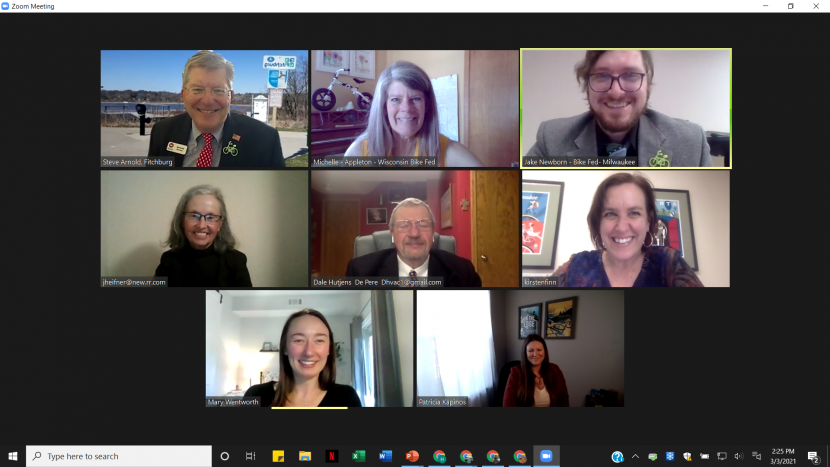
National legislative priorities released at Lobby Day 2021
On March 3rd, the Wisconsin delegation taking part in the League of American Bicyclists Lobby Day met with our U.S. Senators and Congress people to advocate for several legislative initiatives that would make biking better for many across the country
On March 3rd, the Wisconsin delegation took part in the League of American Bicyclists Lobby Day. We met with our U.S. Senators and Congress people to advocate for several legislative initiatives that would make biking better for many across the country.
Federal legislative priorities were laid out as part of the National Bike Summit last week. Hundreds of people from around the country came together virtually to hear from speakers and panelists discuss a variety of topics. Sec. of Transportation Pete Buttigieg presented to attendees on priorities within the USDOT, Charles T. Brown spoke on Arrested Mobility: Exploring the Impacts of Over-policing (i.e., policy, police and polity) BIPOC Mobility in the US. Chairman DeFazio, Rep. Ayanna Pressley and Rep. Blumenauer gave great opening speeches to inspire those watching.
On Wednesday, March 3rd the Wisconsin delegation, comprised of Bike Fed staff, board, and various partners across the state met virtually with staff from Sen. Ron Johnson, Sen. Tammy Baldwin, and Rep. Gwen Moore’s staffers as well as Rep. Ron Kind and Rep. Mike Gallagher met with us “in person”. We spoke on behalf of all people who ride a bike in Wisconsin and had some great conversations. While our representatives in Washington are discussing a COVID recovery bill and working to bring our country out of this pandemic they were welcoming and respectful to our asks. Wheels are still turning in both houses on what the bills, relating to better biking, will look like exactly and much of it will revolve around the passage of the next Federal Transportation bill, likely this spring and summer, or if they have to be passed individually.
While no votes are scheduled at the moment it is not too early to contact our representatives asking them to support better biking. Of course when we learn more and as things progress, we will send out action alerts.

Thank you to the League of American Bicyclists for putting this information together.
H.R. 463 Transportation Alternatives Enhancements
The original TA program was predicated on the idea that local governments should have decision-making power over a small amount of federal transportation funding for local transportation priorities, such as bikeways and sidewalks. HR 463, introduced by Reps. Espaillat and Larsen, makes small changes to restore flexibility to the state, while increasing local control to communities.
Ensure fair increases in and fair distribution of TA funds
» The Problem: Under the FAST Act, TA funding is limited to a dollar amount and does not increase as other transportation programs increase. Under the FAST Act, 50% of TA funds go to a state run grant program, and 50% are distributed to communities based on population.
» The Fix: Change TA funding to a percentage, and change the formula so that two-thirds of the funding is distributed by population for a fairer distribution among communities of all sizes.
Increase local control
» The Problem: Under the FAST Act, large Metropolitan Planning Organizations (MPOs) with populations over 200k can select projects, but can’t obligate funds to projects. Small MPOs, with populations under 200k cannot apply for funds due to a drafting error in MAP-21.
» The Fix: Give large MPOs obligation authority to improve project deliver, and fix the drafting error so that small MPOs are eligible to apply for funds.
Improve project applications
» The Problem: Small and mid-size cities don’t always have the technical capacity to put together strong applications and navigate the implementation process.
» The Fix: Give States access to 5% of TA funds to staff the program, and to offer technical and engineering assistance to local governments and manage the implementation process.
Give States flexibility
» The Problem: Several states would like to tweak the program by helping with local match or by sub allocating all TA funding to local governments.
» The Fix: Allow states to use safety dollars as local match, adjust local match by project as long as the program stays at 80/20, and sub-allocate 100% of their TA if the FHWA approves of the plan.
Ensure local governments can access funds before they are transferred
» The Problem: Under the FAST Act States can transfer up to 50% of TA regardless of whether local governments have applied for the funding, undermining the local focus of the program.
» The Fix: Require states to run a competitive process, offer technical assistance, and to demonstrate that there were not suitable applications before transferring funds.
Prioritize high need areas
» The Problem: Low income, transit dependent or rural areas have a higher need for safe bicycling and walking infrastructure.
» The Fix: The bill will prioritize high need areas in the competitive process. 21 states already do this. The bill allows states to define ‘high need areas.
H.R. 508 – the SAFE Streets Act
Pedestrian and bicyclist fatalities have continued to rise over the last decade, both in real numbers and as a percentage of overall traffic fatalities. Today, despite being 20% of all traffic fatalities, states spend only one percent of their Highway Safety Improvement Program dollars to address vulnerable road user (VRU) safety. Vulnerable road users are people bicycling, walking or using mobility devices (including but not limited to wheelchairs, scooters, etc.). The Safe and Friendly for the Environment (SAFE) Street Act addresses Vulnerable Road User safety by creating a special rule within the Highway Safety Improvement Program to ensure states address the significant and growing safety problem.
The Safe and Friendly for the Environment (SAFE) Streets Act:
» Requires US Department of Transportation to rank states based on VRU fatalities and serious injuries (FSI) per capita and MPOs by VRU fatalities per capita.
» States and MPOs who fall above the median must perform a VRU safety assessment to identify high risk corridors for pedestrians, bicyclists and other vulnerable road users, and suggest projects or strategies to improve safety on those corridors.
» States with above the median FSI per capita will be required to address areas with high rates of VRU based on their assessments.
» If a state has MPOs with above the median fatalities per capita, the state must address areas with high rates of VRU based on MPO assessments.
Current safety formulas have a blind spot: They only pinpoint highway fatality hot spots, which work for automobile crashes, but not for Vulnerable Road Users. Pedestrian and bicyclist fatalities don’t cluster in specific locations, but rather cluster along corridors – very often collector roads that have high speed limits, but limited if any crosswalks, sidewalks or bikeways. We know how to make our roads safer: The Federal Highway Administration has identified and tested proven safety countermeasures that are known to reduce pedestrian fatalities, and will help bicyclist safety too. These include road diets, leading pedestrian intervals, local road safety plans, medians, crosswalks, and more. The SAFE Streets Act creates a special safety rule requiring that states with high fatalities, identify dangerous corridors and develop potential fixes to them. The bill also requires the state invest in known solutions in areas dangerous for people biking, walking and using mobility devices.
Rep. Gwen Moore has been added on as a Co-sponsor of this bill.
Senate: Transportation Alternatives Enhancements
These asks are the same as the House bill but does not have a bill number yet.
S. 425 – The Complete Streets Act of 2021
Complete Streets policies require that communities plan, design and build their streets for all users: a complete street can accommodate pedestrians, bicyclists, and public transit users, not just cars and freight vehicles. For over 15 years, bicyclist and pedestrian organizations have joined the National Complete Streets Coalition and others to advocate for their communities and states to adopt these policies. During that time, more than 1500 Complete Streets policies have been passed in the United States, including by 35 States, Puerto Rico and the District of Columbia.
Now, Congress can show leadership by taking the next step and offering technical assistance, funding, and guidance to local governments as they implement Complete Streets plans nationwide.
» Strengthens language governing the design of federally funded surface transportation projects to require states and MPOs to adopt and implement complete streets standards.
» Requires US DOT to create minimum standards for what a local complete streets policy must include, and
» Requires states set aside 5% of their federal highway funding to establish a technical assistance and construction grant program to help local governments build complete streets projects.
» One in three traffic fatalities is someone outside a car: pedestrians, bicyclists, motorcyclists and people using mobility devices including wheelchairs or scooters. These deaths are due to years of prioritizing traffic speed over safety in transportation engineering and we can prevent these deaths through legislative actions.
» Complete streets policies ensure new roadways are designed safely and efficiently to serve all users, reducing the need for costly redesign in the future.
» The state-level grant program helps communities retrofit where needed, fixing dangerous infrastructure and making transit, bicycling and walking safer and more accessible.
» By having the US DOT set standards and guidance, the bill gives communities a place to start while also allowing flexibility for local context. Requiring federal aid highway are built to the same standards will create consistency.